Nitin Singhania Summary: Indian Music- 1 | History for UPSC CSE PDF Download
| Table of contents |

|
| Introduction |

|
| Anatomy of Indian Music |

|
| Classification of Indian Music |

|
| Fusion of Classical and Folk |

|
| Modern Music |

|
| Musical Instruments |

|
| Modern Development in Music |

|
Introduction
- Music is the soul of any culture.
- India has a long tradition of musical ingenuity.
- Narada Muni (sage) introduced music to Earth and taught the inhabitants about a sound that pervades the entire universe, called Naada Brahma.
- Musical instruments like the seven-holed flute and Ravanahatha were recovered from sites of the Indus Valley Civilization.
- First literary traces of music date back to Vedic times (2000 years ago).
- Sama Veda lists all seven notes of the raga Kharaharapriya in descending order.
- Gandharva Veda, the science of music, is an Upaveda of Sama Veda.
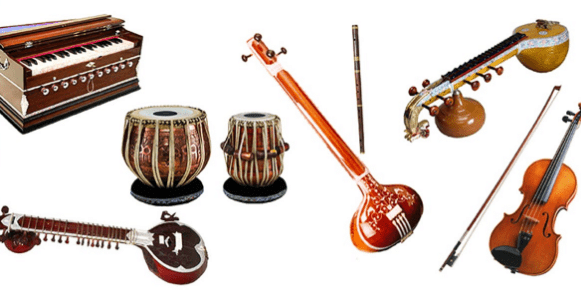 Indian Classical Music Instruments
Indian Classical Music Instruments - Aitareya Aranyaka mentions parts of the Veena.
- Jaimini Brahmana speaks of dance and music.
- Kausitaki Brahmana combines dance, vocal, and instrumental music.
- Theories state that Om is the source of all ragas and notes.
- Panini (500 BCE) made the first proper reference to the art of making music.
- Bharata’s Natyashastra (between 200 BCE and 200 CE) is the first reference to musical theory.
- Development in music was linked with devotional sites. This type of ritualistic music, called Sangama (later Vedic period), involved chanting verses set to musical patterns.
- Epics were set to a narrative type of music called Jatigan.
- Bharata’s Natyashastra: The first work to clarify and elaborate on the subject of musicology. It has several important chapters on music, including those that identified the octave and elaborated on its 22 keys. These 22 keys are called shrutis or srutis. A distinction was made in Dathilam, a text that endorsed the existence of 22 shrutis per octave and suggested that these were likely the only ones the human body could produce.
 Bharata's Natyashastra
Bharata's Natyashastra - Sarangadeva (13th-century musicologist), who wrote the classic text on music, the Sangeet Ratnakara, seconded this view.
- His text defined 264 ragas (from North Indian and Dravidian repertoires).
- Its greatest contribution was identifying and describing different ‘microtones’ and classifying them into different categories.
- Medieval texts on musicology focused on particular themes, for example:
(i) Brihaddeshi (9th century by Matanga) - definition of ‘raga’.
(ii) Sangeeta Makaranda (14th century by Narada) - enumerated 93 ragas and classified them into feminine and masculine forms.
(iii) Swaramela-Kalanidhi (16th century by Ramamatya) - deals primarily with ragas.
(iv) Chaturdandi-prakasika (17th century by Venkatamakhin) - provides important information on musicology. - During the ancient and early medieval period, Gurukuls existed.
- Gurukul System
(i) Known as the Ashram (hermitage) system
(ii) Embodied the Guru-shishya tradition
(iii) Teachers or masters were sages
(iv) Students lived in the hermitage for 12 years
(v) The hermitage was given patronage by kings and wealthy persons in society.
(vi) Life in the hermitage was rigorous, pensive, and full of knowledge
(vii) There was no discrimination among students. - The influx of Islamic and Persian elements changed the face of North Indian music. For example, the Dhruvapad, a devotional style of singing, transformed into the Dhrupad style by the 15th century, and by the 17th century, a new form of Hindustani music, Khayal, had evolved.
- More styles of ‘folk’ singing emerged during this period.
Anatomy of Indian Music
Three main pillars of Indian classical music:
1. Swara
2. Tala
3. Raga
Components of Raga:
(i) Rasa
(ii) Thaat
(iii) Samay
1. Swara
- The term “Swara” is associated with the recitation of the Vedas.
- The term is also used to define a ‘note’ or ‘scale degree’ in a composition.
- In Natyashastra, Bharata divided swaras into a 22-note scale.
- Currently, Hindustani music is defined by Saptak or Sargam - Sa, Re, Ga, Ma, Pa, Dha, Ni.
- He listed each pitch using the following names:
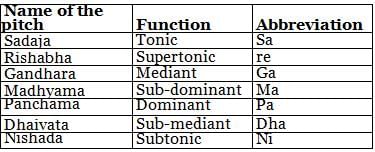
- Swara differs from Shruti.
- Shruti, or microtones, are the smallest gradations of pitch and are 22 in number, out of which only 12 are audible.
- These 12 are seven Shuddha Swaras and five Vikrita Swaras.
2. Tala
- Talas are rhythmic groupings of beats.
- Rhythmical cycles range from three to 108 beats.
- As per the concept of tala, musical time is divided into simple and complicated meters.
- The theory of time measurement is not similar in Hindustani and Carnatic music.
- Tala is unique in that it is independent of the music that accompanies it and has its own divisions.
- Laya is the tempo of tala, which maintains uniformity of time span.
- Currently, only 30 talas are known, and only 10 to 12 talas are actually used.
- Recognized and used talas include Dadra, Kaharva, Rupak, Ektal, Jhaptal, Teental, and Ada Chautal.
- Music composers use Teental, which consists of 16 beats.
- Carnatic music has a more rigid structure than Hindustani music. Talas (thalas) are made of three components: Laghu, Dhrutam, and Anu Dhrutam.
- There are 35 original thalas, each of which can be further split into five ‘ghatis.’ Thus, there are 175 (35*5) thalas in Carnatic music.
3. Raga
- The term comes from the Sanskrit word ‘Ranj,’ which means to delight, make happy, or satisfy a person.
- Ragas are the basis of melody, while tala is the basis of rhythm.
- Each raga has a distinct personality, subject, and mood evoked by its sounds.
- The basic element for the working of a raga is the note on which it is based.
- According to the number of notes in a raga, there are three main jatis or categories:
(a) Audav/Odava Raga - ‘pentatonic’ raga, 5 notes
(b) Shadava Raga - ‘hexatonic’ raga, 6 notes
(c) Sampurna Raga - ‘heptatonic’ raga, 7 notes - A raga is not a scale nor a mode but a scientific, precise, subtle, and aesthetic melodic form with its own peculiar ascending and descending movement, consisting of either a full octave or a series of 5, 6, or 7 notes.
- Three major types of Raga or Raga Bhed:
(i) Shuddha Raag - If any notes absent from the composition are played, its nature and form do not change.
(ii) Chhayalag Raag - If any notes not present in the original composition are played, its nature and form change.
(iii) Sankeerna Raag - There is a combination of two or more ragas. - Every raga should have a basic set of 5 notes:
(a) ‘King’ - the principal note on which the raga is built, called ‘Vaadi,’ and is used most often in the composition.
(b) ‘Queen’ - the fourth or fifth note in relation to the principal raga, the second most important note of the raga, called ‘Samvaadi.’
(c) All other notes in the composition are called Anuvaadi.
(d) The notes not present in the composition are Vivadi. - The ascent of notes is Aaroha, e.g., Sa, Re, Ga, Ma, Pa, Dha, Ni.
- The descent is Avaroha, where each note is lower than the preceding note, e.g., Ni, Dha, Pa, Ma, Ga, Re, Sa.
- Depending on the ascent and descent of notes, ragas can be divided into three speeds or Laya: Vilambit (slow), Madhya (medium), and Drut (fast).
- There are 72 melas or parent scales on which ragas are based.
- There are six main ragas in Hindustani music, all of which are time- and season-specific and evoke particular emotions:
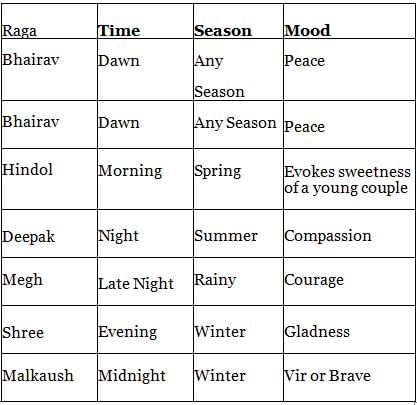
(i) Rasa
- The reason for the creation of ragas is to evoke emotional responses.
- These emotions, called Rasas, are also known as ‘aesthetic delight’ as they consciously make one feel an emotion through someone else’s art.
- Initially, there were eight rasas; later, one rasa called ‘Shanta’ was added to make nine rasas or ‘Navaras.’ These are:

- After the 15th century, Bhakti (rasa of devotion) became widely accepted.
- Musicologists argue that Bhakti and Shanta rasa are one and the same.
- In Natyashastra, Bharata argues that Madhyam evokes humorous instincts, Pancham evokes erotic feelings, Shadja evokes heroic feelings, and Rishabh notes evoke wrathful instincts.
1. Raga forms the basis of Rhythm.
2. Tala becomes the basis of melody.
Which of the above is/are correct?
(ii) Thaat
- It is a system of classification of ragas into different groups.
- In Hindustani classical music, there is a 10-Thaat classification.
- V.N. Bhatkhande (a prominent musicologist in the field of North Indian classical music) states that each traditional raga is based on, or is a variation of, 10 basic thaats or musical scales or frameworks.
- Thaats can only be sung in Aaroha, as notes are composed in ascending order.
- They should have seven notes out of 12 (7 Shuddha Swaras and 5 Vikrita Swaras) and must be placed in ascending order.
- The 10 thaats are Bilawal, Khamaj, Kafi, Asavari, Bhairavi, Bhairav, Kalyan, Marwa, Poorvi, and Todi.
- Thaats have no emotional quality, unlike ragas, and are not sung.
- Rasas produced from thaats are sung.
(iii) Samay
- Each raga has a specific time at which it is performed because its notes are considered more effective at that particular time.
- The 24 hours of a day can be divided into two parts:
i. From 12 AM to 12 PM: Poorva Bhaag, when Poorva ragas are sung.
ii. From 12 PM to 12 AM: Uttar Bhaag, when Uttar ragas are sung. - The saptak also changes according to the period of the day.
In the Poorvang period, the saptak ranges from Sa to Ma (Sa, Re, Ga, Ma).
In the Uttarang period, the saptak ranges from Pa to Sa (Pa, Dha, Ni, Sa).
1. There are five swaras or notes in total in Indian music.
2. Odava raga contains five notes or swaras.
Which of the above is/are correct?
Other Components of the Raga
(a) Alap
- Gradual exposition of a raga, emphasizing Vaadi and Samvaadi in a slow tempo.
- Sung at the beginning of a raga performance, typically in North Indian classical music.
- Usually sung in Aakaar, i.e., without pronouncing any syllables, using only the sound ‘aa’ of the vowels.
(b) Composition: Divided into two parts in Hindustani classical music:
(c) Taan: Basic notes sung at a fast tempo; they are very technical, and speed is an important factor in singing them.
- Particular taans are sung in Aakaar notes.
- A short taan of 3 or 4 notes, called Murki, is sung very fast.
(d) Alankara: Specific melodic presentation in succession in which a pattern is followed.
Example: In combinations of notes like ‘Sa Re Ga’, ‘Ga Ma Pa’, ‘Ma Pa Dha’, etc., an alankar is used in which 3 notes in succession are employed each time.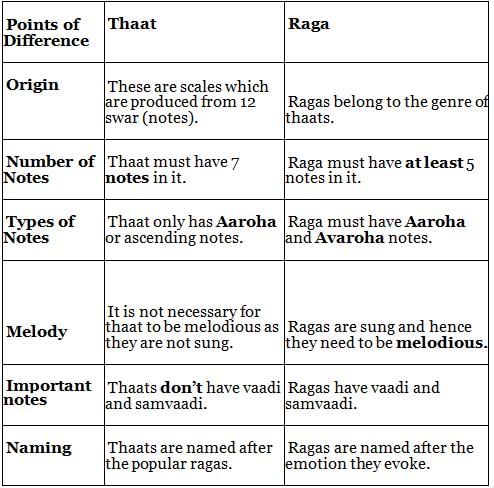
Classification of Indian Music
- The classification of Indian music is as follows:
- Two schools of Indian classical music:
1. Hindustani music: Northern parts of India.
2. Carnatic music: Southern parts of India.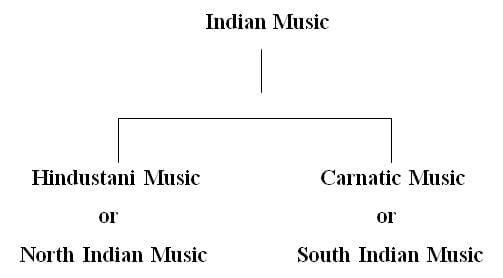
1. Hindustani Music
- The historical roots of both schools trace back to Bharata’s Natyashastra, but they diverged in the 14th century.
- This branch focuses more on musical structure and the possibilities of improvisation.
- It adopted a scale of Shuddha Swara Saptaka, or the ‘Octave of Natural Notes’.
- It includes ten main styles of singing, such as ‘Dhrupad’, ‘Dhamar’, ‘Hori’, ‘Khayal’, ‘Tappa’, ‘Chaturang’, ‘Ragasagar’, ‘Tarana’, ‘Sargam’, and ‘Thumri’. Some major schools are:
(i) Dhrupad
- One of the oldest and grandest forms.
- Mentioned in Natyashastra (200 BCE–200 CE).
- Owes its roots to older forms like Prabhanda and Dhruvapada.
- The name is derived from ‘dhruva’ and ‘pada,’ meaning it denotes both the verse form of poetry and the style in which it is sung.
- Reached its zenith in Akbar’s court, which patronized musical masters like Baba Gopal Das, Swami Haridas, and Tansen (one of the Navaratna, or nine gems).
- Baiju Bawra also sang at the court of Akbar.
- Singers who mastered Dhrupad were in the court of Raja Man Singh Tomar (Gwalior).
- It was a major form of singing during the medieval period.
- It fell into a state of decline in the 18th century.
- Dhrupad is a poetic form incorporated into an extended presentation style marked by precise and overt elaboration of a raga.
- Dhruva means ‘unmoving’ and implies the return of Swara (tonal), Kala (time), and Shabda (textual) trajectories to a fixed point.
- It starts with Alap.
- The tempo rises gradually and forms a major part of the performance.
- It is pure music without the distraction of words.
- After some time, Dhrupad begins, and the Pakhawaj is played.
- It includes the use of Sanskrit syllables and has a temple origin.
- It includes 4 to 5 stanzas and is performed by a duo (generally male).
- The Tanpura and Pakhawaj accompany them.
Dhrupad singing is divided into four forms based on the vanis or banis they perform:
(a) Dagari Gharana
- Sings in Dagar Vani.
- Places great emphasis on Alap.
- Members are trained and perform regularly.
- They are Muslims but sing Hindu texts of gods and goddesses.
- Example: Gundecha Brothers from Jaipur.
(b) Darbhanga Gharana
- Sings Khandar Vani and Gauhar Vani.
- Emphasizes raga alap as well as improvised alap, incorporating a variety of layakari.
- Exponents: Mallik family (performing members include Ram Chatur Mallik, Prem Kumar Mallik, and Siyaram Tewari).
(c) Bettiah Gharana
- Performs Nauhar and Khandar Vani styles.
- Exponents: The Mishras (living member who performs: Indra Kishore Mishra).
- Dhrupad prevalent in Bettiah and Darbhanga schools follows the Haveli style.
(d) Talwandi Gharana
- Sings Khandar Vani; family-based in Pakistan, making it difficult to keep within the system of Indian music.
1. Antara is the first part of a musical composition.
2. Mukhada is the first line of a musical composition.
Which of the above is/are correct?
➢ Gharana System
- A system of social organization linking musicians or dancers by lineage or apprenticeship and by adherence to a particular musical style.
- The word ‘gharana’ comes from the Urdu/Hindi word ‘ghar,’ which means ‘family’ or ‘house.’
- It refers to the place where the musical ideology originated.
- It also indicates a comprehensive musicological ideology and differentiates one school from another.
- It affects the thinking, teaching, performance, and appreciation of music.
- Well-known gharanas for Hindustani classical music include Agra, Gwalior, Indore, Jaipur, and Kirana.
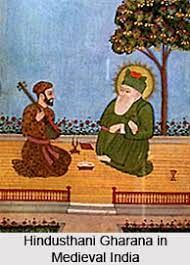
(i) Khyal
- Derived from Persian, meaning “idea or imagination.”
- Its origin is attributed to Amir Khusrau.
- It is the most popular form among artists as it provides greater scope for improvisation.
- It is based on a repertoire of short songs ranging from two to eight lines.
- A Khyal composition is referred to as a ‘Bandish.’
- Sultan Mohammad Sharqi gave significant patronage to Khyal in the 15th century.
- Unique features include the use of taan in the composition and giving less room to Alap, unlike Dhrupad.
- A typical Khyal performance uses two songs:
Bada Khyal: sung in a slow tempo
Chhota Khyal: sung in a fast tempo - Themes for Khyal bandish are romantic in nature, even when related to divine figures.
- Khyal compositions are often in praise of Lord Krishna.
The major Gharanas under Khyal music are:
(a) Gwalior Gharana
- One of the oldest and most elaborate Khyal Gharanas.
- Very rigorous, with equal emphasis on melody and rhythm.
- Singing is complex, but they prefer to perform simple ragas.
- Popular exponents: Nathu Khan and Vishnu Paluskar.
(b) Kirana Gharana
- Named after the town Kirana in Uttar Pradesh.
- Founded by Nayak Gopal.
- Real credit for making it popular goes to Abdul Karim Khan and Abdul Wahid Khan (early 20th century).
- Famous for its concern with precise tuning and expression of notes.
- Better known for mastery over slow-tempo ragas.
- Emphasizes the melody of the composition and the clarity of the pronunciation of the text in the song.
- Prefers the use of traditional ragas or the Sargam.
- Most famous singers: Pandit Bhimsen Joshi and Gangubai Hangal.
- Carnatic exponents from the border regions of Maharashtra and Karnataka are also associated with this gharana.
(c) Agra Gharana
- Historians say Khuda Baksh established it in the 19th century.
- Musicologists say Haji Sujan Khan founded it.
- Revived by Faiyaz Khan.
- Renamed as Rangeela Gharana.
- It is a blend of Khyal and Dhrupad styles. Artists give special emphasis to Bandish.
- Major exponents: Mohsin Khan Niazi and Vijay Kichlu.
(d) Patiala Gharana
- Started by Bade Fateh Ali Khan and Ali Baksh Khan in the 19th century.
- Received initial sponsorship from the Maharaja of Patiala (Punjab).
- Gained a reputation for ghazal, thumri, and khayal.
- Stresses the use of greater rhythm.
- Compositions emphasize emotions because they use ornamentation or alankaras in their music.
- Stresses intricate taans.
- Most well-known composer: Bade Ghulam Ali Khan Sahab (one of India’s greatest Hindustani classical vocalists, who bridged the gap between vocals being limited to an elite audience).
- He was renowned for his rendition of the Raga Darbari.
- The gharana is unique as it uses distinctive taans, gamak, and the gayaki of the tarana style.
(e) Bhendibazaar Gharana
- Founded by Chhajju Khan, Nazir Khan, and Khadim Hussain Khan in the 19th century.
- Singers were trained to control their breath for long periods.
- Artists could sing long passages in a single breath.
- Unique in that some Carnatic ragas are part of their repertoire.
(ii) Tarana Style
- Rhythm plays a crucial role.
- The structure is mainly melody, usually short, repeated many times, with variation and elaboration at the performer’s discretion.
- There is a second, contrasting melody with higher notes, introduced once before returning to the main melody.
- Uses words sung at a fast tempo.
- Singers need specialized training and skills in rhythmic manipulation.
- World’s Fastest Tarana Singer: Pandit Rattan Mohan Sharma (Mewati Gharana). In 2011, he was given the title “Tarana ke Baadshah” (King of Tarana).
Semi-classical Styles of Hindustani Music
- Based on swara (note).
- Slightly deviate from the standard structure of the raga because lighter versions of ragas like Bhoopali or Malkauns are used.
- Employ lighter versions of tala and use madhyam or drut laya, i.e., they are faster in tempo.
- Emphasize more on bhava (emotion) and lyrics than alap-jod-tan-jhala.
- Prominent semi-classical styles like thumri, tappa, and ghazal are discussed below:
(a) Thumri
- Based on mixed ragas.
- Considered semi-classical Indian music.
- Compositions are either romantic or devotional.
- Inspired by the Bhakti movement, so the text often revolves around a girl’s love for Krishna.
- The language of composition is Hindi, Awadhi dialect, or Braj Bhasha dialect.
- Usually sung in a female voice.
- Differs from other forms due to its inherent sensuality.
- Allows the singer to improvise during performance, providing greater flexibility with the use of raga.
- Also used as a generic name for other lighter forms such as Dadra, Hori, Kajari, Saavan, Jhoola, and Chaiti.
Two main types of thumri:
1. Purbi Thumri: Slower tempo.
2. Punjabi Thumri: Fast and lively tempo.
- Its main gharanas are Banaras and Lucknow.
- Begum Akhtar is the most timeless voice for singing thumri.
(b) Tappa
- Rhythm plays a very important role.
- Originated from folk songs of camel riders of North-West India.
- Gained legitimacy as a semi-classical vocal specialty when brought to the Mughal court of Emperor Muhammad Shah.
- Uses very quick turns of phrases.
- Was a genre of choice for both the wealthy elite and classes with more modest means.
- The “baithaki” style evolved under the patronage of the elites of the zamindari classes of the late 19th and early 20th centuries in their baithak-khanas (literally, baithak - assembly, khana - halls or salons) and jalsaghar (literally, halls for entertainment, mujra, or nautch halls).
- The style is now becoming extinct, with few practitioners involved.
- Few exponents of this style: Mian Sodi, Pandit Laxman Rao of Gwalior, and Shanno Khurana.
(c) Ghazal
- A poetic form consisting of rhyming couplets and a refrain, with each line sharing the same meter.
- Expresses the pain of loss or separation and the beauty of love despite that pain.
- Originated in Iran (10th century CE).
- It never exceeds 12 ashaar or couplets.
- Spread to South Asia in the 12th century due to the influence of Sufi mystics and the courts of the new Islamic Sultanate.
- Reached its zenith during the Mughal period.
- Amir Khusrau was one of the first exponents of creating ghazals.
- Historical ghazal poets were either Sufis themselves (like Rumi or Hafiz) or sympathizers with Sufi ideas.
- Ghazal deals with one subject: love, specifically an unconditional and superior love.
- Ghazals from the Indian subcontinent are influenced by Islamic mysticism.
- Originally had complex lyrics requiring education.
- Over the years, ghazals have undergone simplification to reach a larger audience.
- Most ghazals are sung in styles not limited to khyal, thumri, raga, and other classical and light classical genres.
- Famous figures: Muhammad Iqbal, Mirza Ghalib, Rumi (13th century), Hafez (14th century), Kazi Nazrul Islam, etc.
1. In Aaroha, each note is higher than the preceding note.
2. In Avaroha, each note is lower than the preceding note.
Which of the above is/are correct?
2. Carnatic Music
- Creates music played in the traditional octave.
- The music is kriti, which focuses more on saahitya or the lyrical quality of the musical piece and is a highly evolved musical song set to a certain raga and fixed tala or rhythmic cycle.
Every composition in the Carnatic style has several parts:
(a) Pallavi
- The first or second thematic lines of a composition.
- Often repeated in each stanza.
- Considered the ‘Pièce de Résistance’ or the best part of the Carnatic composition called ‘Ragam Thanam Pallavi,’ where the artist has great scope for improvisation.
(b) Anu Pallavi
- Two lines that follow the Pallavi or the first line.
- Sung at the beginning and sometimes towards the end.
- Not necessary to repeat after every stanza or Charanam.
(c) Varnam
- Sung at the beginning of a recital.
- Reveals the raga of the recital to the audience.
- Made up of two parts: Purvanga (first half) and Uttaranga (second half).
(d) Ragamalika
- Usually the concluding part of a performance.
- Extremely important as the soloist is allowed to freely indulge in improvisation.
- All artists must return to the original theme at the end of the composition.
- Several other components of Carnatic music include Swara-Kalpana, an improvised section performed with a drummer in medium and fast paces.
- Carnatic music is typically played with the mridangam.
- The piece of melodic improvisation in free rhythm with the mridangam is called ‘Thanam.’
- Those pieces without a mridangam are called ‘Rasam.’


Early Proponents of Carnatic Music
(i) Annamacharya (1408–1503)
- First known composer of Carnatic music.
- Composed sankirtanas in praise of Lord Venkateswara, a form of Lord Vishnu.
- His compositions were mainly in Telugu.
- Widely recognized as the ‘Grandfather of Telugu Songwriting.’
(ii) Purandara Dasa (1484–1564)
- One of the founding proponents of Carnatic music.
- A devotee of Lord Krishna.
- Widely referred to as the “Pitamaha” or father/grandfather of Carnatic music.
- Believed to be an avatar or incarnation of Sage Narada.
- His famous compositions include Dasa Sahitya.
(iii) Kshetrayya (1600–1680)
- Telugu poet and a prominent composer of Carnatic music.
- Composed numerous Padams and Keertanas.
- His compositions were mainly based on Lord Krishna.
- Traveled from one place to another.
- His Padams are still sung during Bharatanatyam and Kuchipudi performances.
(iv) Bhadrachala Ramadasu (1620–1680)
- A famous proponent of Carnatic music whose compositions were mainly in praise of Lord Rama, mostly in Telugu.
- One of the famous Vaggeyakaras (composers who wrote both lyrics and music).
Other Vaggeyakaras in Telugu include Annamacharya, Tyagaraja, and Syama Sastri (all three born in Tiruvarur). - Most compositions were in Telugu, with a few in Sanskrit, and in praise of Lord Rama.
- A crater on the planet Mercury is named after Tyagaraja.
- Tyagaraja created several new ragas.
3. Folk Music
- Each state has its own form of music.
- Classical music follows rules as laid out in Natyashastra and cultivates a guru-shishya (student-mentor) tradition.
- Folk music is the music of the people and has no strict rules.
- It is based on diverse themes and is often set to beats to be dance-oriented.
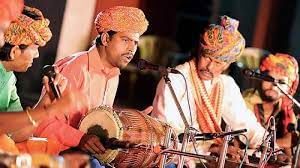 Indian Folk Music
Indian Folk Music
There are several types of folk music associated with a particular state:
1. Baul
- Not only a type of music but also a Bengali religious sect.
- Baul Sangeet is a particular type of folk song.
- Lyrics are influenced by Hindu Bhakti movements and Sufi songs, exemplified by the songs of Kabir, called ‘Baul Gaan’ or Baul songs.
- Represents a long heritage of preaching mysticism through songs in Bengal, like the Shahebdhoni or Bolahadi sects.
- Prominent proponents: Yotin Das, Purna Chandra Das, Lalon Fakir, Nabani Das, and Sanatan Das Thakur Baul.
2. Wanawan
- From the state of Kashmir.
- Sung during wedding ceremonies.
3. Pandavani
- Based on the Mahabharata, with Bhima as the hero.
- Includes gayan (singing) and vadan (playing an instrument). Songs are set to the rhythm of the tambura.
- Most notable artist: Tijanbai from Chhattisgarh, who won the Padma Shri and Padma Bhushan.
4. Alha
- From Madhya Pradesh.
- A heroic ballad song with intricate words.
- Sung in different languages like Braj, Awadhi, and Bhojpuri.
- Also related to the Mahabharata, glorifying the reincarnations of the Pandavas.
- The five Pandavas are substituted here as Alha, Udal, Malkhan, Lakhan, and Deva.
5. Panihari
- From Rajasthan.
- Related to water.
- About women fetching water from wells in matkas.
- Addresses the scarcity of water and the long distance between wells and villages.
- Also discusses daily concerns of village women, chance encounters between lovers, or contentious relationships between mothers-in-law and daughters-in-law.
6. Ovi
- From Maharashtra and Goa.
- Songs of women, sung during leisure time.
- Consist of four small lines of poetry and are written for marriages, pregnancies, and as lullabies.
7. Pai Song
- From Madhya Pradesh.
- Sung during festivals that occur during the rainy season.
- Songs of the farmer communities.
- Plead for a good monsoon and a bountiful harvest.
- Saira dance is performed with it.
8. Lavani
- The most famous folk dance from Maharashtra.
- The most popular genre of music in Maharashtra.
- Performed with the dholki, a percussion instrument.
- Has a powerful rhythm.
9. Maand
- From Rajasthan.
- Developed in royal courts and hence recognized in classical circles.
- Neither a full-fledged raga nor a freely rendered folk song.
- Usually about bards singing the glory of Rajput rulers.
- Is similar to Thumri or Ghazal.
- The song Kesariya Balam is in this style.
10. Dandiya
- Also known as Raas or Dandiya Raas.
- A traditional folk dance form of Gujarat.
- Associated with Holi and the lila of Krishna and Radha at Vrindavan.
- Performed during Navratri evenings in Western India (Dandiya Raas - Gujarat).
- Several forms of Raas, but “Dandiya Raas” is the most popular.
- Other forms of Raas:
1. Dang Lila, Rajasthan - one large stick is used.
2. Rasalila, North India. - Rasalila and Dandiya Raas are similar.
- Garba, a form of Raas, is called “Raas Garba.”
11. Powada
- From Maharashtra.
- Ballads sung for heroes of the past, like Shivaji.
- Describe the events of their glorious past and heroic deeds.
12. Khongjom Parva
- Folk music from Manipur.
- A popular ballad genre.
- A musical narration of the Battle of Khongjom fought between the British army and the Manipuri resistance forces in 1891.
13. Bhavageete
- Emotional songs.
- Very popular in Karnataka and Maharashtra.
- Very close to ghazals.
- Sung at a slower pitch.
- Composed on themes around nature, love, and philosophy.
14. Mando
- From Goa.
- A blend of Indian and Western musical traditions.
- Instruments used include guitars, violins, and the ghumot drum.
15. Kolannalu or Kolattam
- From Andhra Pradesh, Karnataka, and Tamil Nadu.
- Similar to Dandiya.
- An ancient dance form involving movement in a rhythmic fashion.
- Songs and music are played along with the dance.
- Other major folk music traditions from the country are:
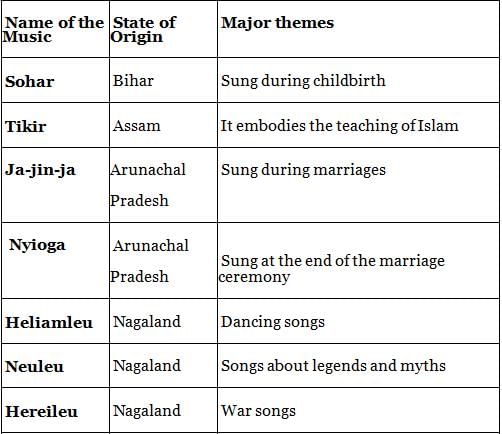
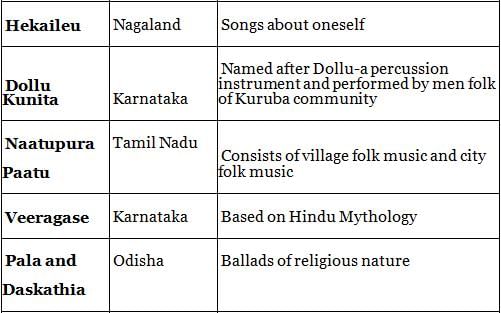
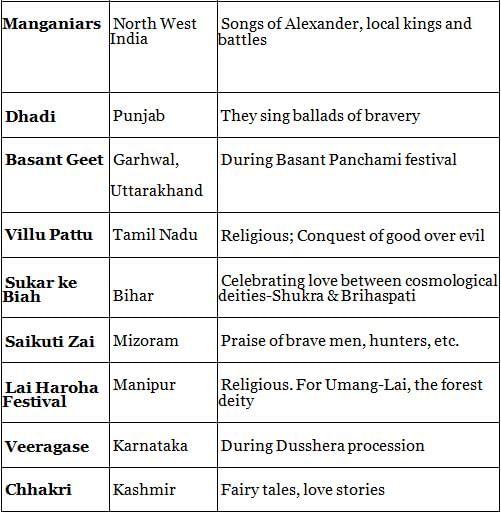

Fusion of Classical and Folk
Devotional music usually takes elements from both classical and folk traditions.
Some of the styles are:
1. Sugam Sangeet
- A genre of devotional music.
- Takes cues from earlier forms of music like Prabandha Sangeet and Dhruvapada, which were also devotional.
Sub-categories in this genre are as follows:
(a) Bhajan
The most popular type of devotional singing in North India.
- Originated from the Bhakti movement.
- Popular subjects include stories from the lives of gods and goddesses or from the Mahabharata and Ramayana.
- Accompanied by musical instruments like the chimta, dholak, dhaphli, and manjira.
- Major exponents (medieval period): Mirabai, Tulsidas, Surdas, Kabir, etc.
- Famous bhajan singers: Anup Jalota and Anuradha Paudwal.
(b) Shabad
- Devotional songs sung in Gurdwaras.
- Popularized by Guru Nanak and his disciple Mardana.
- Three types of Shabad singing: raga-based Shabad singing, traditional shabads (from the Adi Granth), and lighter ones.
- Best-known Shabad singers: Singh Bandhus (Tejpal Singh, Surinder Singh) and Bhai Santa Singh.
(c) Qawwali
- Sung in praise of Allah, Prophet Muhammad, or major Sufi or Islamic saints.
- Composed in a single raga and written in Urdu, Punjabi, or Hindi.
- Words from Braj Bhasha and Awadhi are also used.
- Performed in Sufi shrines.
- Sung solo or in groups with two lead singers and a team of eight.
- Instruments used include tabla, dholak, and harmonium.
- Amir Khusrau is credited with the origin of Qawwali, though this is heavily disputed.
- Major Qawwals: Sabri Brothers, Nusrat Fateh Ali Khan, Aziz Warisi, etc.
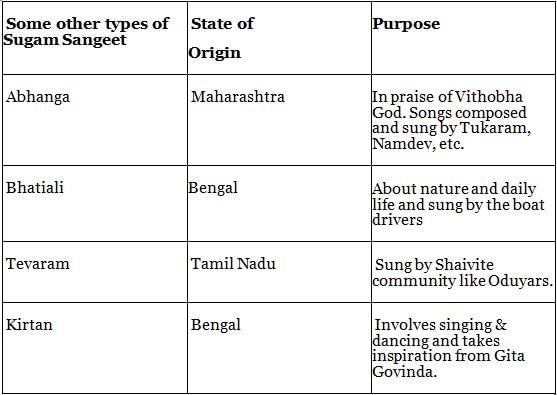
2. Rabindra Sangeet
- The most famous form of music composition in Bengal, recreating the music of Nobel Laureate Rabindranath Tagore.
- A mixture of classical elements and Bengali folk strains.
- More than 2,000 Rabindra Sangeet compositions exist.
- Themes include worship of one true god, devotion to nature and its beauty, love, and a celebration of life.
- Its most prominent emotion is a strain of patriotism.
3. Gana Sangeet
- Fusion music sung in chorus.
- Focuses on patriotic feelings and includes songs of protest against malpractices in society.
- The most popular example is Vande Mataram.
4. Haveli Sangeet
- Developed in Rajasthan and Gujarat but also seen in many parts of the country.
- Originally sung in temple premises but now performed outside temples.
- Practiced by the Pushtimarg Sampradaya, a community that believes in Pushtimarg as the path to salvation.
Modern Music
1. Rock
- Rock music in India, called Indian Rock, blends elements of Indian music with mainstream rock music.
- One of the first Indian rock singers: Usha Uthup.
- Unique features: Indian musicians began fusing rock with traditional Indian music from the mid-1960s onwards.
- Western music and cultural interactions have impacted Indian Rock.
- The influence of Indian classical music on 1960s rock started with George Harrison’s Ravi Shankar-inspired raga rock song “Norwegian Wood (This Bird Has Flown)” in 1965 and The Beatles’ public sojourn with the Maharishi Mahesh Yogi at his ashram in Rishikesh in 1968, following the release of Sgt. Pepper’s Lonely Hearts Club Band in 1967.
2. Jazz
- Originated in India in the 1920s in Bombay, when African-American jazz musicians performed in posh hotels.
- Goan musicians took cues from them.
- 1930s–1950s: The ‘Golden Age of Jazz Music in India.’
- Black musicians who came to India to avoid racial discrimination in the USA: Leon Abbey, Crickett Smith, Creighton Thompson, Ken Mac, Roy Butler, Teddy Weatherford.
- Became predominant in Bombay, with centers like the Taj Mahal hotel ballroom.
- Similarities between jazz and Indian classical music: both involve improvisation.
- In the 1940s, Indo-jazz, consisting of jazz, classical, and Indian influences, emerged.
- Pioneers of the fusion of jazz and Indian music: Ravi Shankar, John Coltrane, etc.
- Indian classical music also impacted free jazz (a subgenre of jazz).
3. Pop Music
- Indian elements combined with pop music are called Indi-pop, Indipop, or Hindipop.
- The British-Indian fusion band Monsoon used the term ‘Indipop’ for the first time in their album in 1981.
- Indian pop music was popularized in the early 1990s by Alisha Chinai, in collaboration with Biddu and MTV India.
- Indipop took an interesting turn with the “remixing” of old Indian movie songs by adding new beats, but this attempt at reinventing IndiPop faced severe criticism and eventually led to the end of the IndiPop phase in India.
- Current pop musicians: Mohit Chauhan, Mika Singh, Raghav Sachar, Papon, etc.
Musical Instruments
Four major traditional categories of musical instruments, depending on the type of instruments included. They are:
1. Avanaddha Vadya
- Membranophone instruments where an outer membrane is struck to produce particular musical sounds.
- Also called percussion instruments.
- Have one or two faces covered with hide or skin.
- The most ancient of these is the Bhumi Dundubhi, or earth drum.
- Includes tabla, drum, dhol, congo, mridangam, etc.
- The tabla accompanies Hindustani classical vocals, while the mridangam accompanies Carnatic music performances.
2. Sushira Vadya
- Aerophones, including wind instruments.
- Most common: bansuri (flute), shehnai, pungi, ninkirns, etc.
- The shehnai, a double-reeded wind instrument with a widening tube towards the end, is one of the most common yet difficult-to-play instruments and among the oldest wind instruments in India.
- Ustad Bismillah Khan, known as the ‘Shehnai King.’
- The flute, used since the Vedic period, was initially called Nadi or Tunava and is the most common instrument.
- Lord Krishna playing the flute is an icon of Hindu imagination.
- Pandit Hariprasad Chaurasia, India’s most famous flutist.
3. Ghana Vadya
- Solid instruments that do not require tuning.
- Also called idiophone instruments.
- Popular examples: manjira, jaltarang, kanchtarang, jhanj, khartal, etc.
- Manjira, a small brass cymbal used in temples.
- Archaeological excavations date the manjira to the Harappan civilization.
- These instruments keep rhythm and time with the song being sung.
4. Tata Vadya
- Chordophones or string instruments.
Three major types:
(a) Bowed
Sound is produced by drawing a bow across the strings.
Sarangi, esraj, and violin.
(b) Plectral
Strings are plucked by fingers or by a plectrum of wire or horn.
Sitar, veena, and tambura.
(c) Instruments struck by a small hammer or a pair of sticks.
Gotuvadyam and swaramandal.
- The Bhangash family, pioneers of the sarod (20th century).
- Gharanas playing the sitar: Jaipur, Varanasi, and Etawah (Imdadkhani) Gharanas.
- The veena, one of the most ancient and revered instruments, is associated with Goddess Saraswati and belongs to this category.
5. Santoor
A 100-string instrument and a traditional instrument of Jammu and Kashmir from ancient times. Sufiana kalam music is accompanied by the santoor.
Folk Musical Instruments
1. Chordophones(i) Tumbi: Played during Bhangra in Punjab.
(ii) Ektara or Tun Tuna: A one-stringed instrument played by wandering monks.
(iii) Dotara: A two-stringed instrument used by Bauls.
(iv) Chikara: A bowed instrument used in Rajasthan, Uttar Pradesh, and Madhya Pradesh.
(v) Dilruba or Esraj: An accompanying instrument used in Punjab and during Rabindra Sangeet in eastern India.
(vi) Onavillu: From Kerala, made of bamboo.
(vii) Sarinda: An important tribal instrument used by the Santhals in eastern India, Rajasthan, and Assam. It is similar to the sarangi.
2. Aerophones
(i) Pungi or Been: Used by snake charmers, made of dried bottle gourd and two bamboo sticks.
(ii) Algoza: A double flute used in northwest India, especially Punjab.
(iii) Tangmuri: Used by the Khasi hill people of Meghalaya.
(iv) Titti: Like a bagpiper, made of goatskin, used in south India, especially Kerala and Andhra Pradesh.
(v) Mashak: An instrument of the Garhwal region in Uttarakhand, also used in Rajasthan and Uttar Pradesh.
(vi) Gogona: Made of bamboo and used during Bihu in Assam.
3. Membranophones
(i) Ghumot: Like a drum, played during the Ganesh festival in Goa.
(ii) Idakka: Like a damru, from Kerala.
(iii) Udukai: An hourglass-shaped instrument like a damru, from Tamil Nadu.
(iv) Sambal: Like a drum, played with sticks in the Konkan region, Maharashtra.
(v) Tamak: An important instrument of the Santhal tribe, a two-headed drum beaten with drumsticks.
(vi) Diggi: A folk drum from Ghariya village in Uttar Pradesh.
4. Idiophones
(i) Chimpta: Evolved from fire tongs, used in Punjab.
(ii) Gharha: Earthen pots used in folk music in Punjab.
(iii) Andelu: Used in Burra-Katha, a pair of hollow metal rings.
Modern Development in Music
Some of the important developments are:
(i) Gandharva Mahavidyalaya
- Established by V.D. Paluskar in 1901.
- Purpose: teaching and transmitting knowledge of Indian classical music and dance to future generations.
- Initially opened in Lahore but shifted to Mumbai in 1915.
- Focuses on Hindustani and Carnatic classical forms of music.
- Has a devotional approach, leading to the establishment of the Prayag Sangeet Samiti in Allahabad.
(ii) Prayag Sangeet Samiti
- Established in 1926 at Allahabad (now Prayagraj) to impart education in Hindustani classical music.
1. Pandit Bhimsen Joshi
2. Gangu Bhai Hangal
3. Vishnu Palushkar
Who of the above belong to Kirana Gharana of Dhrupad style of music?
(iii) Sangeet Natak Akademi
- The first national academy set up for the arts by the Government of India in 1952.
- Major focus: creating a setup for music, drama, and dance in India.
- Intended to be the primary body for showcasing performing arts in the country.
- Promotes the vast intangible heritage of India.
- Central agency to monitor the preservation of cultural heritage, collaborating with state and Union Territory governments to preserve and promote their culture on a national platform.
- Administers several institutions focusing primarily on dance, music, or drama.
- For example, it oversees the National School of Drama, established in 1959 for focused work on dramatics in India.
(iv) Marris College of Music
- A premier institute for studying classical music in India.
- Founded by Vishnu Narayan Bhatkhande in 1926.
- Established in his place of origin, Lucknow.
- Later renamed Bhatkhande Music Institute.
(v) Spic Macay
- Established by Kiran Seth in 1977.
- Full form: Society for the Promotion of Indian Classical Music and Culture Amongst Youth.
- A voluntary youth movement to showcase India’s culture to the masses, especially younger generations losing touch with Indian classical roots.
- Aims to promote Indian classical music, dance, and other aspects of Indian culture.
- Targets laypeople and youth by holding many free-entry events.
- Has grown into a large organization with over 200 chapters or branches worldwide.
1. A raga must have at least five notes or swaras in it.
2. Raga has only Aaroha or ascending notes.
Which of the above is/are correct?
Communities Related to Music
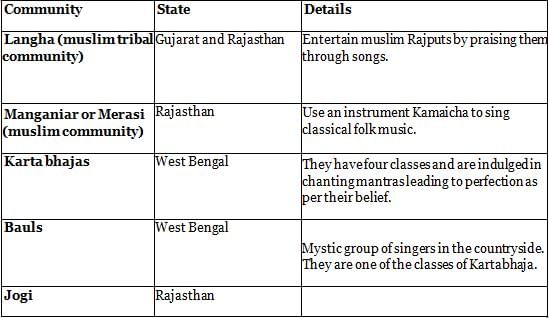

Chaturprahar
- An annual Indian classical music festival held at the National Centre for Performing Arts in Mumbai.
- Based on the concept of associating time with ragas.
To practice questions on the topic "Indian Music," attempt the test given below:
|
109 videos|653 docs|168 tests
|
FAQs on Nitin Singhania Summary: Indian Music- 1 - History for UPSC CSE
| 1. What is the classification of Indian music? |  |
| 2. What is the difference between Carnatic music and Hindustani music? |  |
| 3. What are some popular musical instruments used in Indian music? |  |
| 4. What is the fusion of classical and folk music in Indian music? |  |
| 5. What is the modern development in Indian music? |  |
















